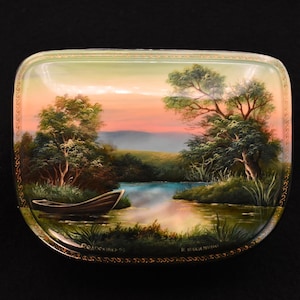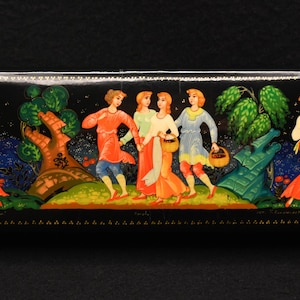







Prints and Art
Antique 1841 W.H. Bartlett Engraving Print - 'Indian Scene on the St Lawrence'
-
DetailsWilliam Henry Bartlett is one of the most well-known and revered artists of the 19th century. His etchings and engravings have made their way into countless publications and are largely considered some of the most influential historical drawings of the 19th century.
Born in 1809, Bartlett quickly found his love for drawing. He was apprenticed to John Britton, an architect and antiquarian, and became one of the foremost illustrators of topography of his generation. His love of drawing coupled with his master's love of history made him a perfect candidate to illustrate the history of the world, prior to photographic technology. He took several trips to Canada and the Americas to illustrate the landscape, buildings and people. In 1835, Bartlett first visited the United States to draw the buildings, towns and scenery of the northeastern states. The finely detailed steel engravings Bartlett produced were published, uncolored, with a text by Nathaniel Parker Willis as: "American Scenery; or Land, Lake, and River: Illustrations of Transatlantic Nature." "American Scenery" was published by George Virtue in London and solidified Bartlett's reputation as one of the most skilled artists of the time. Bartletts primary concern was to render "lively impressions of actual sights", as he wrote in the preface to The Nile Boat (London, 1849). Many views contain some ruin or element of the past including many scenes of churches, abbeys, cathedrals and castles, and Nathaniel Parker Willis described Bartlett's talent thus: "Bartlett could select his point of view so as to bring prominently into his sketch the castle or the cathedral, which history or antiquity had allowed".
Bartlett took at least 3 trips to the North American continent. His most extensive journey saw him begin in Quebec (there are no verified accounts of his travels through the Canadian Maritimes), travel westward to Niagara Falls and then take the Erie Canal to Owego, NY, before departing back to England. Although he took several trips, we can only confirm that which has been found in personal letters and correspondence. However, his multiple trips produced some of the most stunning natural engravings ever to have been published.
INDIAN SCENE ON THE ST LAWRENCE
Original steel engraving, engraved by J.C. Armytage after W. H. Bartlett. 1841.
It is between Pages 90 and 91 of the book: Canadian Scenery Volume 2.
https://archive.org/details/McGillLibrary-123891-2173/page/n120/mode/thumb
As with most Bartlett prints, the detail is staggering. The colours are simply beautiful and one can even see the details of the Native dress. There is no discolouration to the print or the paper and the frame is in admirable condition.
It is a beautiful piece and would make a wonderful addition to any print collection.
As always, should you have any questions or comments, I'm very happy to return messages almost instantly.
Thanks for visiting C&K! -
Shipping & Policies
Shipping from Canada
Processing time
1-2 business days
Customs and import taxes
Buyers are responsible for any customs and import taxes that may apply. I'm not responsible for delays due to customs.
Payment Options
Returns & Exchanges
I gladly accept returns and exchanges
Just contact me within: 3 days of delivery
Ship items back to me within: 7 days of delivery
I don't accept cancellations
But please contact me if you have any problems with your order.
The following items can't be returned or exchanged
Because of the nature of these items, unless they arrive damaged or defective, I can't accept returns for:
- Custom or personalized orders
- Perishable products (like food or flowers)
- Digital downloads
- Intimate items (for health/hygiene reasons)
Conditions of return
Buyers are responsible for return shipping costs. If the item is not returned in its original condition, the buyer is responsible for any loss in value.
Frequently Asked Questions
Can I combine delivery on multiple items?
Of course! We'd be happy to assist. Just send us a quick message and we'll make sure to combine your items into a single package to reduce the shipping costs.



